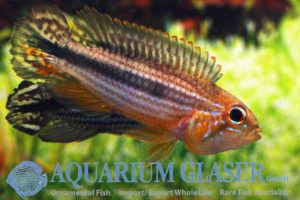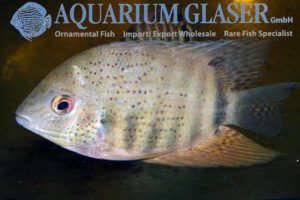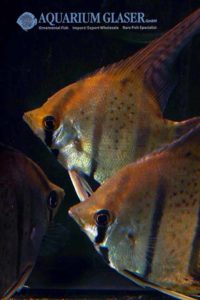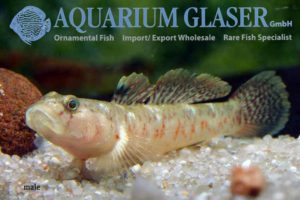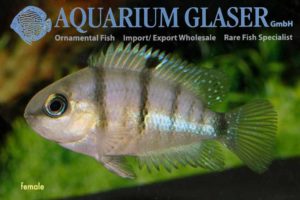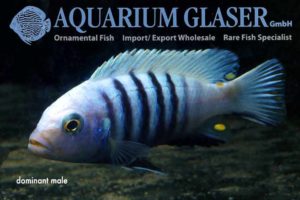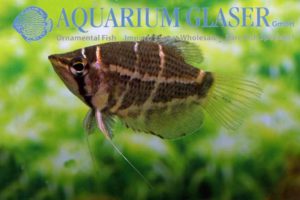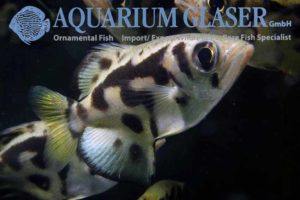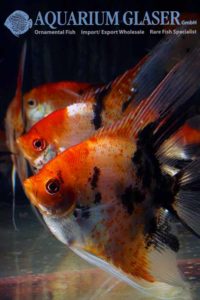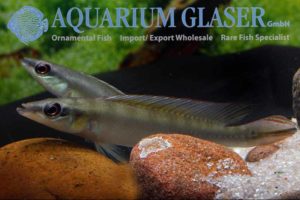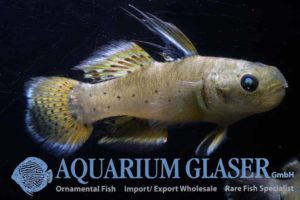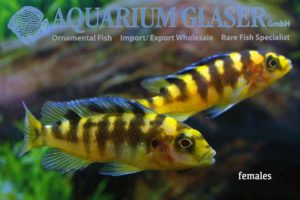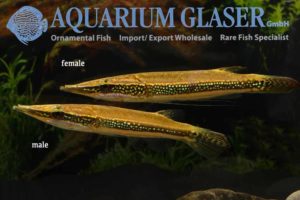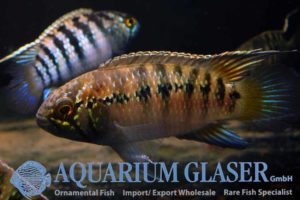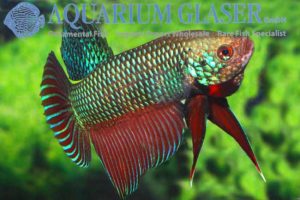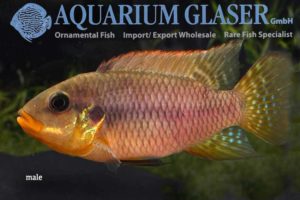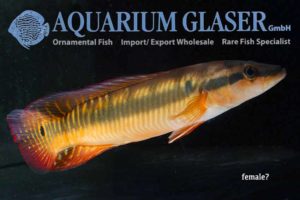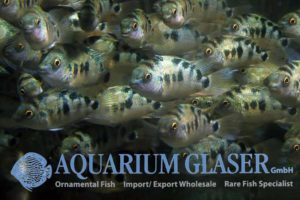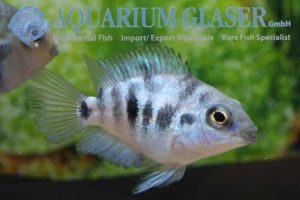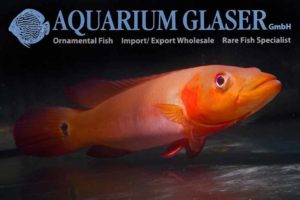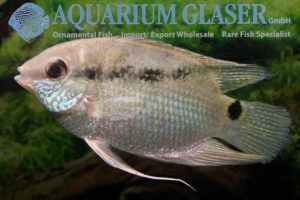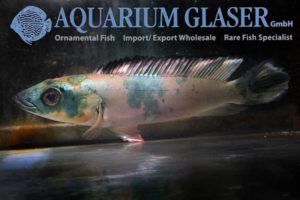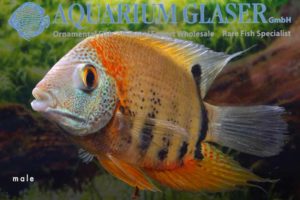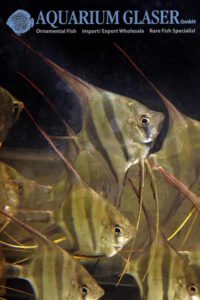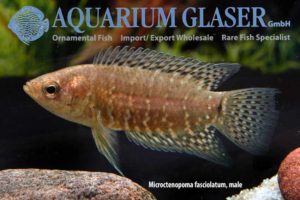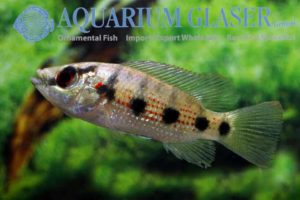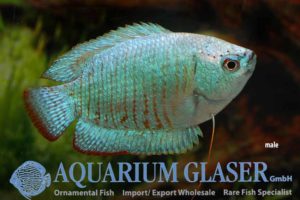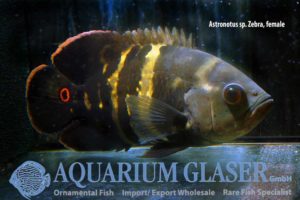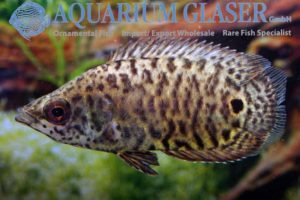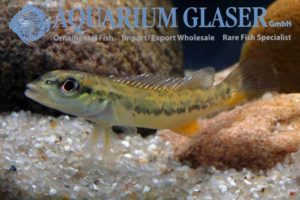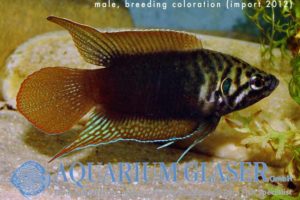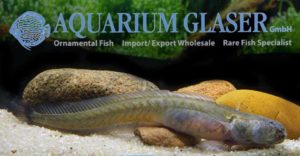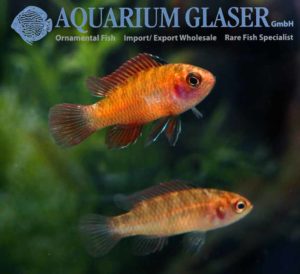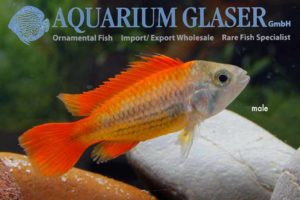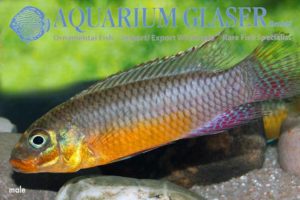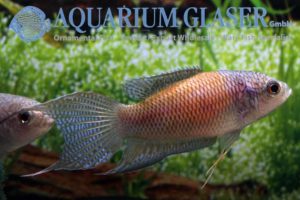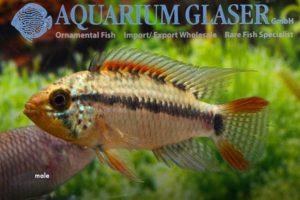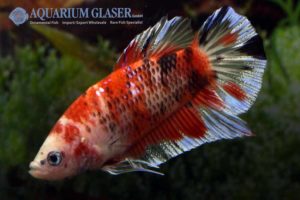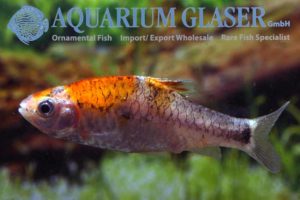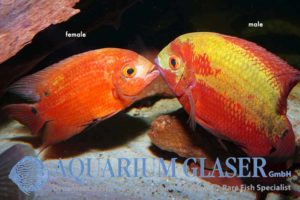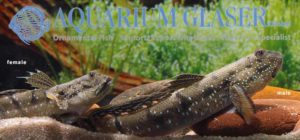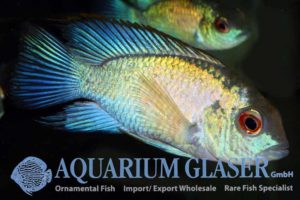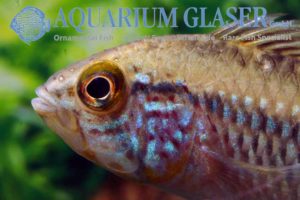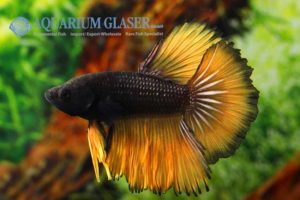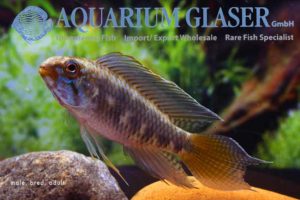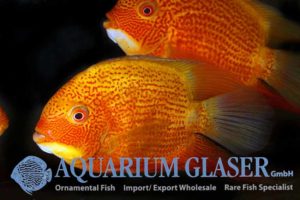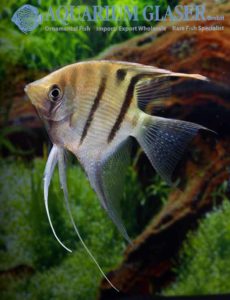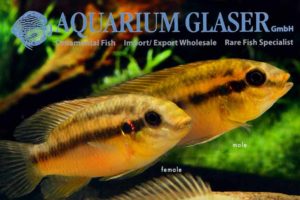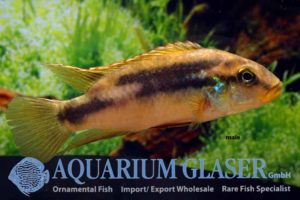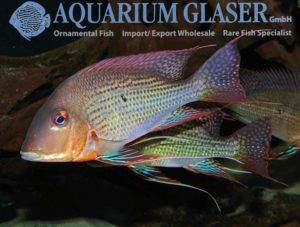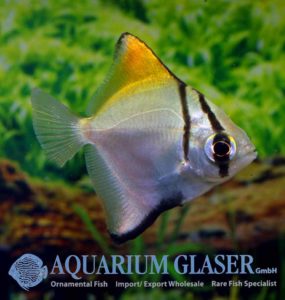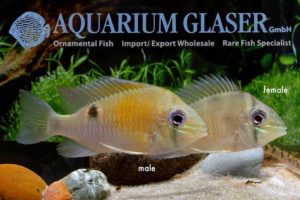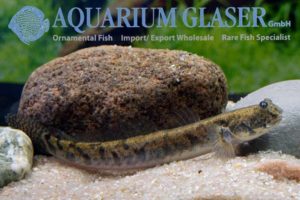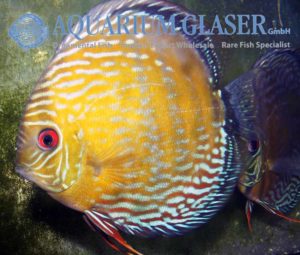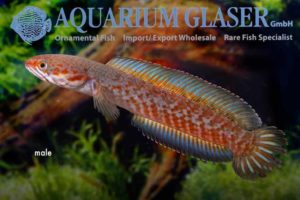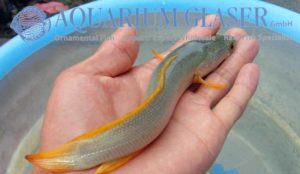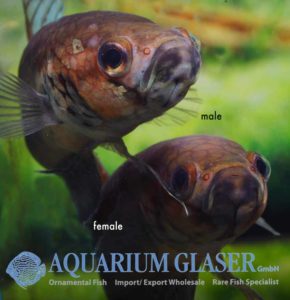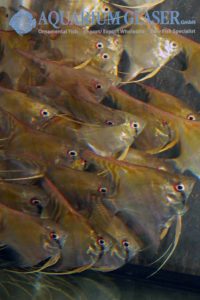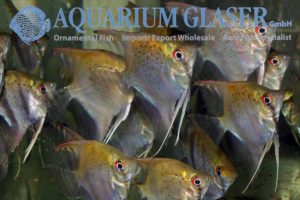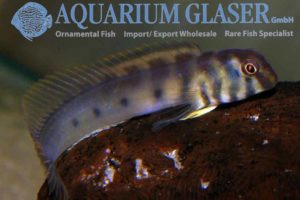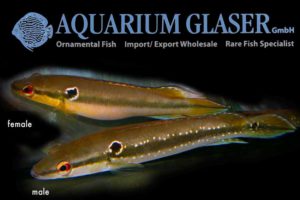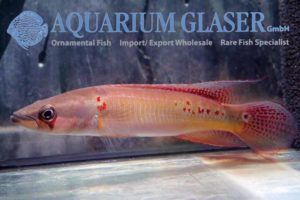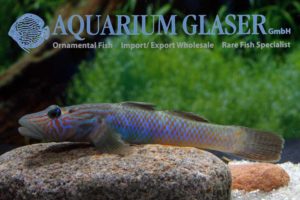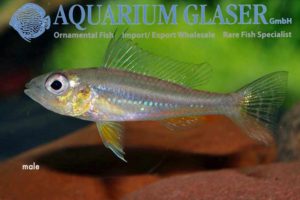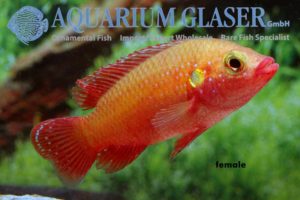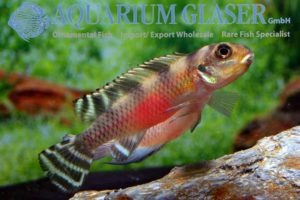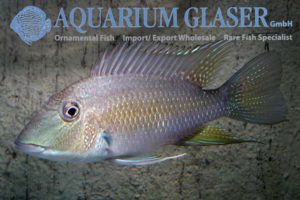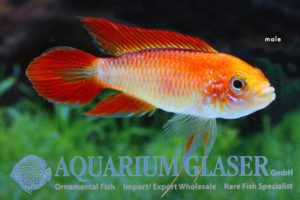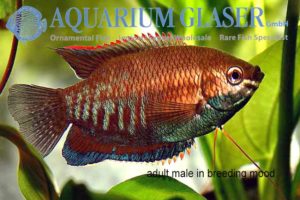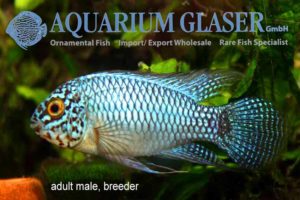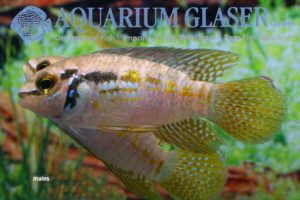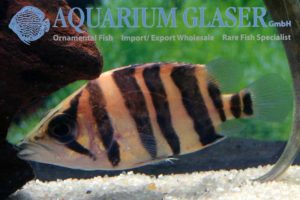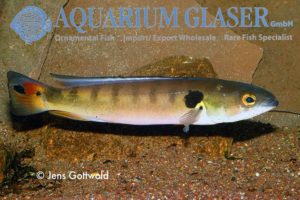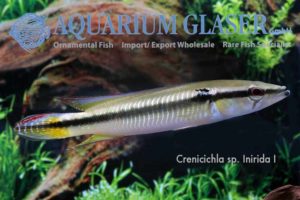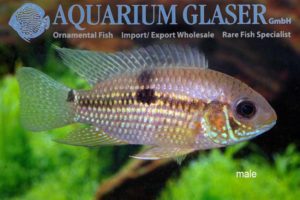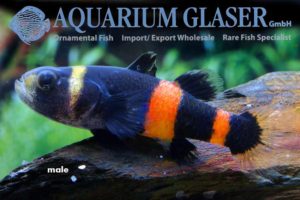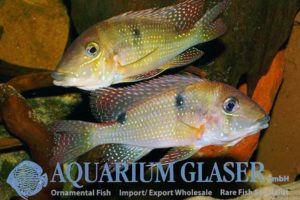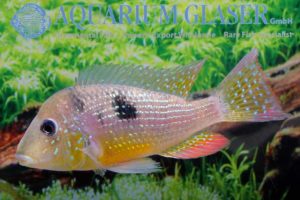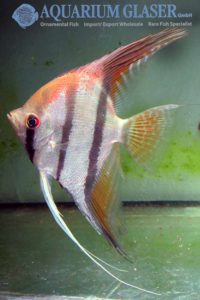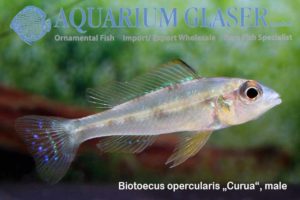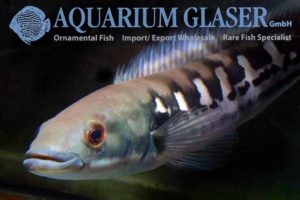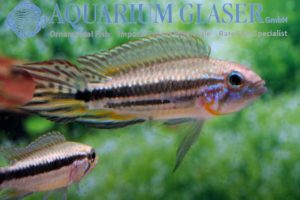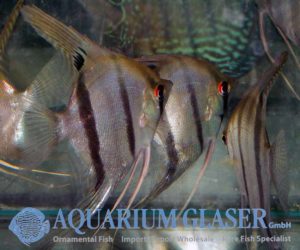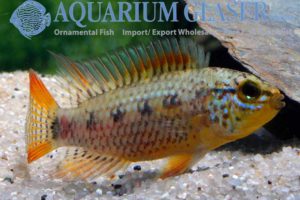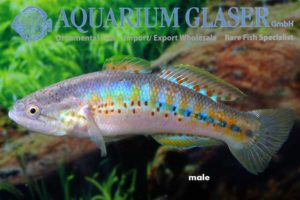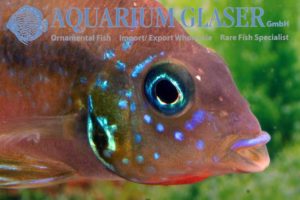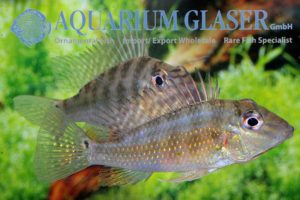We received extremely beautiful wild collect specimens of this most desirable variety of Apistogramma agassizii. The fish show the stripes on the belly, which are so characteristic for the Tefé-variety and additionally they have the yellowish-reddish back of the Santarém-variety. Gorgeous! For our customers: the fish have code 614772 on our stocklist. Please note that […]
25. Perchlike fishes (860)
-
-
Heros cf. efasciatus Japaueri
We received from Brazil beautiful wild collected Heros. According to our supplier the fish have been collected in the Rio Negro in the municipal Japaueri. The most obvious difference to other varieties of Heros are the red spots all over the body. Besides this the new imported Heros obviously become sexually ripe quite early. Our […]
-
Pterophyllum wild “leopoldi Peru spotted”
We received two species of wonderful, large, wild collected angels from Peru. One of them is traditionally called “Pterophyllum leopoldi” in the hobby. It has a reddish back and a number of red spots on the flanks. The name, however, bases on a mis-identification. The “real” P. leopoldi originates from Brazil and is in truth […]
-
Rhinogobius rubromaculatus
In the aquarium hobby we only started in discovering the large diversity of the small freshwater gobies of the genus Rhinogobius. This time the scientists were faster: 116 species have been described to date already! Sadly the distinguishing features that allow the determination of the species cannot be seen in many cases in live specimens. […]
-
Cryptoheros cutteri
We received very nice German bred specimens of this smaller cichlid from Honduras. Despite the comparatively small size – males obtain a maximum length of 13 cm, females always stay smaller – one should not keep these cichlids in small tanks. They have a very vivid temper, especially when they care for the offspring. The […]
-
Cynotilapia pulpican
At the first glimpse Cynotilapia look very much alike the Malawi Zebras of the genus Maylandia In contrast to the zebras, in Cynotilapia the teeth are monoscupid (with two cusps in zebras). This difference is of more importance than one should think, for the zebras feed on Aufwuchs (eg the algae film on rocks etc. […]
-
Sphaerichthys selatanensis
Sphaerichthys selatanensis The season for crossband chocolate gouramis has started. Finally the pretty small anabantoid is available again. For more information please see http://www.aquariumglaser.de/en/fish-archive/labyrinthfish-en/Sphaerichthys_selatanensis_en/ For our customers: the fish has code 455822 on our stocklist. Please note that we exclusively supply the wholesale trade. Text & photos: Frank Schäfer
-
Toxotes blythii
This archer fish that lives exclusively in freshwater originates from Burma. It has been discovered as early as 1860 and received its correct scientific name in 1892. Since then it has not been found anymore. Only in 2004 the first specimens appeared in the international trade and were celebrated as a sensation. These first specimens […]
-
Scalare Red Devil Show Size
We received 50 gorgeous, fully grown Red Devil Angels. The fish are German bred ones. Our opinion is: more colour is impossible! For our customers: the fish have code 697565 on our stocklist. Please note the we exclusively supply the wholesale trade. Text & photos: Frank Schäfer
-
Crenicichla regani Alenquer
The pike cichlids (Crenicichla) represent the most species-rich genus of cichlid at all. More than 130 species have been described. How many of them are valid is subject of discussions, but the number for sure increases to over 90. Some species become pretty large, more than 30 cm, but there are also real dwarf cichlids […]
-
Stigmatogobius sadanundio
Most species of goby are ground dwelling fishes. Only few species have a free swimming behaviour. The knight goby is one of these rare exceptions. We can offer this pretty goby from India on a regular basis. Knight gobies live in estuaries and can live both in pure fresh and in pure marine water. However, […]
-
Pseudotropheus crabro
The colorful mouthbrooders from Lake Malawi – the so called mbuna – belong to the most popular aquarium fish over decades already. They are also called the “coralfish of freshwater”, for – like their salty relatives – they unite splendid colours and a rather quarrelsome temper. The latter is due to the very restricted food […]
-
Luciocephalus aura
The pikeheads (Luciocephalus) are highly specialized labyrinth fish. They live as predators in blackwaters of Southeast Asia. Only two species are known, the “common” pikehead, which occurs on the Malay Peninsula and in Indonesia, and the Peppermint Pikehead, which is known so far only from the Province Jambi on Sumatra. Currently we are able to […]
-
Ivanacara (= Nannacara) adoketa
Finally we could import again some wild collected specimens of this breathtaking beautiful dwarf cichlid. The fish are very lively and have very nice colours. All pictures were made in our fishhouse and show our current stock! Moreover we can offer German bred ones. For more informations on Ivanacara adoketa see http://www.aquariumglaser.de/en/fish-archive/dwarfcichlids-en/Nannacara_adoketa_en/ and http://www.aquariumglaser.de/en/fish-archive/dwarfcichlids-en/Nannacara_adoketa_2_en/ For […]
-
Betta smargdina wild
-
Benitochromis riomuniensis
We have some wild collected specimens of Benitochromis riomuniensis from Cameroon in stock. Benitochromis is closely related to the Pelvicachromis species and can be compared regarding the aquarium biology quite good with these peaceful and colorful cichlids. In contrast to Pelvicachromis, which are cave brooders, Benitochromis are biparental, ovophilous mouthbrooders. This means that both parents […]
-
Crenicichla zebrina
Does there exist anything like a dreamfish even in our days? Well, at least Crenicichla zebrina from Venezuela is a hot candidate! We were able to import two specimens of this top rarity which have a length of 15-20 cm. So far no external features are known for that species to separate males from females. […]
-
Amatitlania sp. Honduras Red Point
Recently we could introduce to you this pretty dwarf cichlid that belongs to the closer relationship of the Convict cichlid (Amatitlania nigrofasciatum, formerly Cichlasoma n.), see http://www.aquariumglaser.de/en/news/Amatitlania_sp_Honduras_Red_Point_en/Now we obtained again specimens from our proved breeder. For our customers: the animals have code 674452 on our stocklist. Please note that we exclusively supply the wholesale trade. […]
-
Amatitlania sp. Honduras Red Point
The Convict cichlid (Amatitlania nigrofasciatum, formerly Cichlasoma, Archocentrus or Cryptoheros nigrofasciatus) was for a long time one of the most popular species of cichlid in the aquarium. Nowadays it becomes rather rarely seen. Instead of that species another Amatitlania appreared some years ago on stage, named Amatitlania sp. “Honduras Red Point”. These fish seem not […]
-
Crenicichla sp. Tapajós
At the beginning of this week we introduced to you the dwarf cichlid Teleocichla proselytus from the Rio Tapajós (see http://www.aquariumglaser.de/en/news.php#1040). A close relative, but much, much bigger is the gorgeous red Crenichichla sp. Tapajós that originates from the same river. The species is not described scientifically yet. Females (sadly too shy for a good […]
-
Mesonauta festivus
We received from Brazil very nice, wild collected flag cichlids. M. festivus is usually not kept due to its coloration, which is not very spectacular, but due to the interesting and peaceful behaviour. But the animals that reached us now have a very interesting, blue pattern in the face. The scales also show an attractive […]
-
Crenicichla lugubris Jutai
Once more we were able to import some specimens of this gorgeous large cichlid from the Jutai region. This time the shipment contained one male with an extraordinary marble pattern. For more informations please click http://www.aquariumglaser.de/en/news/Crenicichla_lugubris_Jutai_en/ For our customers: the fish have code 670746 on our stocklist. Please note that we exclusively supply the wholesale […]
-
Heros cf. efasciatus Red Shoulder
We received wonderful wild collected specimens of this extraordinary species from Peru. Currently the fish are 9-12 cm long. Experts are still debating whether these fish belong to the species Heros efasciatus or to a scientifically still undescribed species of Heros. But all agree that they represent the most attractive Heros at all. Males can […]
-
Altum angels: bred ones available!
We obtained very beautiful German bred Pterophyllum altum. The “Orinoco” strain is characterized by the very good shape of the body and a high degree of red in the fins. For our customers: the fish have code 698303 on our stocklist. Please note that we exclusively supply the wholesale trade. Text & photos: Frank Schäfer
-
Microctenopoma fasciolatum
Our current import from the D.R. Congo contains inter alia two pretty species of dwarf bushfish: Microctenopoma ansorgii and M. fasciolatum. While M. ansorgii, the Orange bushfish, is imported on a rather regular basis, M. fasciolatum is found only very rarely in the trade. The Striped bushfish – this is the common name of M. […]
-
Hemichromis elongatus
The Five Star General has a very wide distribution in western Africa and is one of the most beautiful species of cichlid at all. Sadly it is also one of the most aggressive species of cichlid and this is the reason why it is only very rarely seen in aquaria. The photographed specimens originate from […]
-
Colisa lalia Cobalt
Dwarf gouramis are the orchids among the freshwater aquarium fish. They are extremely beautiful, but also a bit of delicate, but if kept properly they are real eyecatchers. The Cobalt sport was developed only in the 1990ies and became very popular. Today the fish is among the most common species found in the ornamental fish […]
-
Large wild collected Zebra Oscars arrived!
The Oscar (Astronotus ocellatus) is by far the most popular species of large cichlid from South America. This is not only because it is so splendid coloured, but also due to its behaviour: the fish becomes much larger than 20 cm, but is of calm nature and can thus be kept and bred properly in […]
-
Ctenopoma acutirostre wild
The current import from the D. R. Congo also contained some wild collected leopard bushfish. This species is available as bred from Indonesia in the last years (see http://www.aquariumglaser.de/en/archiv.php?news_id=140), but wild collected ones are very rare in the trade. The animals show an extremely variable pattern, each individual has a different coloration. One of our […]
-
Teleocichla proselytus
We received this very rarely offered dwarf cichlid from the Rio Tapajós in Brazil. Like in the humphead cichlids of the genus Steatocranus in Africa, Teleocichla have a reduced swimming bladder; because of that they exclusively live near the bottom. Our specimens have very nice orange colours in the fins. For our customers: the fish […]
-
Macropodus ocellatus wild
Finally we were able to import again wild collected Chinese Paradise fish. The currently imported variety shows an interesting striped pattern in neutral mood. Males in breeding mood look wonderful and have very splendid colours. However, as our animals are not in breeding mood yet, we show here exceptionally a picture of a male that […]
-
Odontamblyopus rubicundus
This goby from the lower reaches of the river Ganges belongs clearly to the category “faces that can be loved only by a mother”. Despite the look the fish that can reach up to 25 cm in length are very interesting. One should be careful with possible tankmates. Any fish that fits the mouth will […]
-
Dario hysginon (2)
The species of Dario – the Dwarf Badis – are in one respect comparable to their larger cousins of the genus Badis: they are Chameleon fish! Depending on mood or light the colours change a lot and fast. We have once more the Flame Red Dario, D. hysginon, from Burma in stock. The species becomes […]
-
Apistogramma cacatuoides Mega Orange
An orange sport of the cockatoo dwarf cichlid is already known for quite a long time. But now we received for the first time a new strain that has really wonderful orange coloration. The breeder calls it “Mega Orange” – and we agree! For our customers: the fish have code 617343 on our stocklist. Please […]
-
Pelvicachromis taeniatus Bipindi
Currently we can offer a great number of wild collected varieties of P. taeniatus from different localities in Cameroon. The local variety from Bipindi is characterized by a high degree of yellow colours, the females get a wonderful blue belly when displaying. For our customers: the fish have code 562702 on our stocklist. Please note […]
-
Macropodus erythropterus
Not much has been heard in the past few years about this beautiful paradise fish from Vietnam. This might be connected with the dispute about the validity of the species which has been considered to be a mere synonym of M. spechti (formerly: M. concolor) by some scientists. We recently obtained bred specimens that clearly […]
-
Apistogramma sp. Xingu / Vielfleck
We received wonderful, fully grown bred specimens of this beautiful dwarf cichlid. The species is still undescribed scientifically. For our customers: the animals have code 628744 on our stocklist. Please note that we exclusively supply the wholesale trade. Text & photos: Frank Schäfer
-
Betta splendens KOI
For the first time ever we could import a few specimens of this spectacular new sport. This is the first sport of Betta splendens that has been selected especially for the look from the top. Alike in Koi only very few specimens among thousands of offspring have a coloration that make a common Betta splendens […]
-
Betta splendens KOI
Again we could import a few specimens of this spectacular new sport. We received short finned ones (“Half Moon Pla Kat”) and veiltails (“Super Delta”). This is the first sport of Betta splendens that has been selected especially for the look from the top. Alike in Koi only very few specimens among thousands of offspring […]
-
Hypselecara temporalis OYAPOC
The Emerald cichlid has become a bit out of fashion. This is a quite sad thing, for this impressive large cichlid – males can become up to 30 cm long, females always stay much smaller – is one of the most beautiful species of cichlid of South America. For the first we can offer now […]
-
Boleophthalmus boddarti
The mudskippers (Oxudercinae) represent a subfamily on their own within the goby family (Gobiidae). One can observe all steps from “normal”, aquatic species (for example in the genus Apocryptes) to partially land-dwelling, amphibic species (Periophthalmus) within the Oxudercinae. Members of the genus Boleophthalmus don´t leave the water completely, but can be found in zones of […]
-
Aequidens (Nannacara) Neon Blue
For all aquarists that feel that Electric Blue Rams are too delicate and Rocio octofasciata “Blue Dempsey” too aggressive: here is an alternative breed from Singapore. The fish are sold under the name of “Nannacara Neon Blue”. Despite the fact that we are quite sure that these fish do not belong to the genus Nannacara […]
-
Apistogramma urteagai
This pretty dwarf cichlid from the Madre de Dios region in Peru is offered only very occasionally. The species is quite undemanding and thus a perfect subject for beginners who want to collect first experiences in keeping and breeding dwarf cichlids. A. urteagai does not require any special water conditions, this is another advantage of […]
-
Betta splendens Mustard Gas
There is no accounting for taste. But without any doubt the name “Mustard Gas”, which is one of the most disgusting chemical weapons, is a bad offense against good taste. The fish nevertheless are extremely beautiful. It is said that initially an US breeder named Jude Als has bred the first Mustard Gas Bettas. However, […]
-
Apistogramma uaupesi
This is without any doubts one of the most attractive dwarf cichlids. Fully grown males show a very variable coloration, a fact that led to different common names in the past, like “Rotkeil-Apistogramma” (which means “Red-Wedge-Apistogramma”) or “Blutkehl-Apistogramma” (which means “Blood-Throat-Apistogramma”). However, according to most current knowledge, all these varieties appear in the wild together […]
-
Heros severus Gold-Red-Spot
We obtained gorgeous, fully grown eyespot cichlids of that sport from a German breeder who kept them in a 1.800 liter tank. These fish are real eyecatchers! For our customers: the animals have code 661617 on our stocklist. Please note that we exclusively supply the wholesale trade. Available in limited numbers only! Text & photos: […]
-
Pterophyllum leopoldi
This is the third commonly accepted species of angelfish. The two other species are Pterophyllum altum and P. scalare. However, traditionally P. leopoldi is named “Dumerili” in hobby and trade, but P. dumerili is a synonym of P. scalare. P. leopoldi originates from Brazil. Here it lives syntopically with P. scalare. P. leopoldi always swims […]
-
Pelvicachromis silviae
Finally we were able once more to import this pretty dwarf cichlid (males become 7-8 cm long, females stay 15-25% smaller) from Nigeria. Before its official description under the name of P. silviae the species has been known by hobbyists for about 40 years as Pelvicachromis sp. aff. subocellatus. For our customers: the fish have […]
-
Benitochromis finleyi Mungo
This medium sized cichlid reaches a maximum length of about 12 cm. The very beautiful fish are pair-bonding oviphilic mouthbrooders. In repect of water chemistry the species is astonishingly adaptable. One should keep them in larger aquaria, for the fish can be become quite gruff against each other. For our customers: the fish have code […]
-
Geophagus altifrons Curua Una
All species of Geophagus are gorgeous fish, but G. altifrons – the species can be recognized by the shape of the lateral spot, which is always smaller than the diameter of the eye – is one of the most beautiful of all. We currently can offer German bred specimens which belong to the population of […]
-
Monodactylus argenteus
Are you planning already your tanks for the upcoming year? Maybe you try a brackish water tank? A large aquarium with a school of monos (Monodactylus argenteus) is a real eyecatcher and a perfect opportunity to learn about all the other interesting species that like it a bit salty. Text & photos: Frank Schäfer
-
Biotodoma cupido Peru
The small cichlid Biotodoma cupido – the species can attain a maximum length of about 12-15 cm, but is sexually mature already at 6-8 cm total length – is probably the species of cichlid with the widest distribution in Amazonia. However, experts are merrily discordant wether all the different looking populations represent only varieties of […]
-
Pseudapocryptes elongatus
We could import this charming goby once more from India. It is a kind of mudskipper, but does never leave the water completely. It only swims in very shallow water. Against each other these mudskippers are absolutely peaceful. They feed readily on any type of usual fishfood. The maximum length is around 20 cm, but […]
-
Discus Royal Blue Nhamunda Maracanha
We continue our journey through the magical world of recently imported wild collected discus with these magnificent animals. Available in very limited numbers only! You will find a small video of the fish on our facebook page: https://www.facebook.com/media/set/?set=vb.119893808211837&type=2 For our customers: the animals have code 731358 on our stocklist. Please note that we exclusively supply […]
-
Channa andrao
One of the smallest and most colorful species of snakehead has been described recently. Since about 12 years this fish is in the trade under the name of Channa sp. “Blue bleheri”. This mouthbrooding species becomes sexually mature at a length of about 8 cm. In the wild, they hardly ever become larger than 10 […]
-
Channa White Pearl Lemon
We were able to import this attractive snakehead for the first time ever. In all probability it is a sport of Channa argus. Thus we expect that these animals can reach a length of 30-40 cm, exceptionally even 90 cm. And this is the good news: with every centimeter the fish grow they become more […]
-
Betta unimaculata
We received beautiful, fully grown, about 8 cm long specimens of this peaceful, mouthbrooding Betta as German bred. Keeping these fish is problem free, but one should know that Betta unimaculata is an excellent jumper, for it lives in brooks in the wild. So the tank must be covered carefully. For our customers: the fish […]
-
Scalar Amapa Red Back
Code: 699668
-
Scalar Essequibo
It is a bit amazing, but the wild varieties of the angel fish appeared in the focus of aquarists only recently, despite the fact that angelfish are among the most popular oramental fish at all. A very pretty variety with many re spots occurs in the Essquibo river in Guyana. We get them as German […]
-
Omobranchus zebra
Once more we could import this charming freshwater blennie. For more information on the species, please see http://www.aquariumglaser.de/en/news/Omobranchus_zebra_en/ For our customers: the fish have code 439742 on our stocklist. Please note that we exclusively supply the wholesale trade. Text & photos: Frank Schäfer
-
Crenicichla sp. Inirida IV
For the first time ever we were able now to import another species of pike cichlid from the surroundings of Puerto Inirida in Colombia. This species is illustrated and described in the German book “Die Buntbarsche Amerikas Bd. 3” by Rainer Stawikowski and Uwe Werner as Crenichla sp. Inirida IV. This is also a very […]
-
Crenicichla sp. Inirida III (= Fire Spot)
Once more we were able to import a small number of this extraordinary beautiful pike cichlid. Many specimens are obviously fully grown already, the fish have sizes of 8 – 15 cm. For our customers: the fish have code 673583 (8-10 cm), 673584 (10-12 cm), and 673585 (12-15 cm). Please note that we exclusively supply […]
-
Rhinogobius formosanus
We could import this pretty brook-goby from Taiwan. The specific name of the fish refers to the old name of the island – Taiwan was formerly known as Formosa. The fish can attain a maximum length of about 8 cm. One should not keep them along with too small other fish, for the gobies may […]
-
Biotoecus dicentrarchus
We have very nice, healthy specimens of this extremely rare dwarf cichlid from Venezuela in stock. For more information, please see http://www.aquariumglaser.de/en/news/Biotoecus_special_en/ For our customers: the fish have code 634483 on our stocklist. Please note that we exclusively supply the wholesale trade. Available in very limited numbers only! Text & photos: Frank Schäfer
-
Hemichromis sp. Firelips
We received from a German breeder these pretty Jewel Cichlids. The fish cannot assigned to any species that is scientifically described. Possibly it represents a hybrid. If so, it is a very well done cross! The lateral spot that is so typical for most species of Jewel Cichlid is missing completely. The bright red lips […]
-
Nanochromis transvestitus
We obtained beautiful bred specimens of this charming dwarf cichlis. Males of the species becomes around 6 cm long, females stay smaller. This makes Nanochromis transvestitus one of the smallest cichlid species at all. The species originates from the Lac Mai Ndombe region in the D.R. Congo. In contrast to most other congolese fishes, N. […]
-
Satanoperca jurupari Tocantins
We received very nice, approximately 15 cm long Satanoperca jurupari from the Rio Tocantins in Brazil. This eartheater is only seldom available. For our customers: the fish have code 678506 (12-15 cm) and 676507 (14-17 cm) on our stocklist. Please note that we exclusively supply the wholesale trade. Available in limited numbers only! Text & […]
-
Apistogramma agassizii Super Fire Red
We received extraordinary beautiful specimens of this sport. Available in limited numbers only! For our customers: the animals have code 614883 on our stocklist. Please note that we exclusively supply the wholesale trade. Text & photos: Frank Schäfer
-
Colisa cf. labiosa INLE
These gouramis belong to a scientifically still undescribed species, which is close to C. labiosa. The parents of our fish have been collected during a private collecting trip in Burma in Lake Inle. Our specimens are adult German bred ones. Very nice fish! The maximum length of the species is around 8 cm. For our […]
-
Apistogramma sp. STEEL BLUE
We received German bred ones of this magnificent Apistogramma. Very colorful! For our customers: the fish have code 628613 on our stocklist. Please note that we exclusively supply the wholesale trade. Text: Frank Schäfer, photos: Frank Schäfer, Rainer Hoyer
-
Laetacara araguaiae
Finally we were able to import once more this charming dwarf cichlid. The fish was known in the hobby under the name of Laetacara sp. “Buckelkopf” ( = humphead) before the scientific description. For more informations, please click http://www.aquariumglaser.de/en/news/Laetacara_araguaiae_en/ For our customers: the animals have code 603002 on our stocklist. Please note that we exclusively […]
-
Datnioides microlepis
Finally we were able to import once more the most beautiful species of tiger perch, the Indonesian Tiger Fish. These large growing predators can reach a maximum length around 50 cm and are wonderful show fish for large aquaria. But our imports are still young, 4-6 cm long. There are two populations of this perch, […]
-
Crenicichla sp. Jatapu
We were able to import a very special pike cichlid, belonging to the closer relationship of Crenicichla strigata/marmorata/lenticulata. Only one pair reached us, which is currently 20-25 cm long and thus not fully grown yet. According to the well known specialist for pike cichlids, Jens Gottwald (who supplied us a nice picture of a fully […]
-
Crenicichla sp. Inirida I and III
We received in very small numbers these beautiful pike cichlids from Venezuela. Crenicichla sp. Inirida III has the special feature of red spots in the pattern (see also http://www.aquariumglaser.de/en/crenicichla-sp-fire-spot-venezuela–sp-inirida-iii_de_1495.html for the picture of an adult male). In Crenicichla sp. Inirida I the shape of the shoulder spot is unique and the males develop a very […]
-
Aequidens patricki
This cichlid originates from a comparatively small collecting site in Peru. That´s why Aequidens patricki is imported only very occasionally. In the wild, the species lives in soft and acidic water. However, the species is very hardy and adapts well to variable water conditions in the aquarium. Another positive fact is that this species is […]
-
Brachygobius doriae
This is by far the most beautiful species of the bumblebee gobies. The males develop a splendid orange-red in the vertical bands of the body and tail. Females most often have yellow bands, but despite the colours they can be easily recognized by the comparably smaller head. The species has been confused with B. xanthozonus […]
-
Geophagus harreri
For the first time ever we can offer this pretty eartheater. The parents originate from Suriname (exactly: the Tapanahoni river. However, the species occurs also in other rivers of Suriname, like the Maroni river, for example). The fish prefer a moderate to strong current, but change to habitats with less current for breeding. Keeping conditions: […]
-
Gymnogeophagus caaguazuensis
We received wonderful wild collected specimens of this mouthbrooding cichlid (the females orally broods the larvae and young fry) from Paraguay. This species attains a maximum length of about 9 cm only (standard length, with the caudal fin the maximum length is around 12 cm) and thus is one of the smallest members of the […]
-
Fantastic Pterophyllum scalare Santa Isabel arrived!
Yesterday reached us wonderful wild collected angels from Santa Isabel. The picture has been taken from one of the fish that arrived yesterday! The fish have a beautiful coloration and are in a perfect condition. For more information see http://www.aquariumglaser.de/en/pterophyllum-scalare-santa-isabel_de_1487.html For our customers: the fish have code 699835 on our stocklist. Please note that we […]
-
Biotoecus special
For the first time ever we can offer both species of Biotoecus that have been described scientifically so far at the same time! Both species are among the rarest fish in the trade and this is the reason why it is so remarkable to have both of them in stock. Moreover, we can offer for […]
-
Crenicichla marmorata Lago Maracana
Lago Maracana is famous among aquarists for its beautiful discus. We now received for the first time ever two wonderful Crenicichla marmorata from that lake. The fish are currently 20-25 cm long. For our customers: the animals have code 671066 on our stocklist. Please note that we exclusively supply the wholesale trade. Text & photos: […]
-
Apistogramma paucisquamis and A. mendezi
Apistogramma mendezi Although Apistogramma mendezi can be imported only occasionally and is also rarely bred the beautiful species is known to develop a great number of local varieties. Additionally males of the very same local population show a high degree of polychromatism. The term polychromatism means that animals can show a differing individual colour pattern […]
-
Biotoecus dicentrarchus
Currently we can offer an absolute rarity from Venezuela: Biotoecus dicentrarchus. In this dwarf cichlid the male attains a maximum length of about 6 cm, the female of about 4-5 cm. The fish are sandbottom dwellers. For breeding the male builds a large sandhill where the pair is spawning. For our customers: the fish have […]
-
Pterophyllum sp. Jatapu
Breathtaking, large, wild collected angelfish originating from the Rio Jatapu in Brazil arrived on wednesday. These animals have a very distinct black spot in the dorsal fin. We have never seen before such markings in angelfish. Possibly the angels represent a new, undescribed species. Even though the photo can – of course – not yet […]
-
Apistogramma sp. Xingu (Vielfleck)
Apistogramma sp. Xingu is a Brazilian species of Apistogramma which is still undescribed scientifically. Like many Apistogramma species this fish has a number of varieties. We just received beautiful large bred specimens of the “Vielfleck”-variety (Vielfleck = many spots). For our customers: the fish have code 628744 on our stocklist. Please note that we exclusively […]
-
Mogurnda adspersa
We obtained wonderful, 6-8 cm long German bred specimens of this Australian sleeper goby. For our customers: the animals have code 436353 on our stocklist. Please note that we exclusively supply the wholesale trade. Text & photos: Frank Schäfer
-
Thorichthys-Week at Aquarium Glaser
The genus Thorichthys originates from Central America. Formerly the fish were grouped in the catch-all genus Cichlasoma. The best known species is the fire mouth cichlid, Thorichthys meeki. All Thorichthys are very beautiful. Compared with other cichlids, Thorichthys are also quite peaceful. Currently we have a good number of species of Thorichthys in stock, which […]
-
Satanoperca rhynchitis
We received beautiful German bred specimens of this rare eartheater. Until the species has been described in 2012 under the name of Satanoperca rhynchitis it was known in the hobby as Satanoperca sp. “Red Lips”. The fish develop the pretty red lips only when adult, so we add a picture of an adult specimen to […]
- « Previous Page
- 1
- …
- 4
- 5
- 6
- 7
- 8
- 9
- Next Page »
Pearl cichlids – German bred ones available!

The
Pearl cichlid has been imported and successfully bred in Germany as
early as 1902. In the meantime there were several changes regarding the
name. Formerly known under the name of Cichlasoma cyanoguttatum it is
now a member of the genus Herichthys. It is believed that the large
spotted form, which we can offer right now as German bred ones, belongs
to the species Herichthys carpinte that originates from Mexico, whereas
the small spotted form is thought to represent the “real” Herichthys
cyanoguttatum. The latter is the only native cichlid of the US and the
northernmost species of cichlid at all.


Sadly
Pearl cichlids are almost forgotten nowadays. So we are always glad
when once per year one of our breeders offers us this beautiful fish.
Currently the animals are 4-5 cm long. However, maximum length for the
species reported is about 30 cm. Large specimens are among the most
colorful species of cichlid at all!
For our customers: the fish have code 644502 on our stocklist. Please note that we exclusively supply the wholesale trade.
Text & photos: Frank Schäfer
Violet Gobies arrived!

Sadly
we can offer the Violet Goby, Gobioides broussonnetii, only very
occasionally. Now we obtained once more a shipment from Colombia that
contained this odd bottom dweller. The maximum length reported in
literature for this fish is around 40 cm. These gobies are absolutely
peaceful plankton feeders. Fine sand should be offered for this fish on
the bottom of the tank.

For our customers: the fish have code 254683 on our stocklist. Please note that we exclusively supply the wholesale trade.

Text & photos: Frank Schäfer
Discus Brown wild / Cameta

Actually, it is
not the high season for wild collected discus. Nevertheless we obtain
now and then wonderful specimens. Currently we could import Brown Discus
from Cametá situated at the Rio Tocantins. The graceful animals, which
have perfect proportions, show a high degree of red coloration.

For our customers: the fish have code 731905 on our stocklist. Please note that we exclusively supply the wholesale trade.


Text & photos: Frank Schäfer
Wonderful Neon gobies arrived

The Neon gobies of the genus Stiphodon are very difficult to determine, for the larvae develop in marine environment; so the species have a very wide distribution. The adult fish, however, live exclusively in freshwater.




The males can change their coloration in a glimpse; the mating coloration is species-specific. Different species look extremely similar in neutral colour, see for example the picture with Stiphodon cf. atratus and S. ornatus. Our specimens belong in all probability for the larger part to the species Stiphodon ornatus, among them are a few Stiphodon weberi as by-catch.



Neon gobies are very peaceful fish that feed on Aufwuchs. They prefer clear, clean and fast running water.

For our customers: the fish have code 456072 on our stocklist. Please note that we exclusively supply the wholesale trade.
Text & photos: Frank Schäfer
The discus season has started (2)!

Despite extremly high water levels (four meter over the normal level of the season) the first wild collected discus of the new season came in. They are very beautiful; today, our focus is on the Blue Discus originating from the Madeira River. This particular variety differs much in coloration individually.


For our customers: the fish have code 731195 on our stocklist.


Please note that we exclusively supply the wholesale trade.
We have placed a video of the fish on our Facebook page….just click here!
We would be happy if you “like” it 😉
Text & photos: Frank Schäfer
The discus season has started!
Despite extremly high water levels (four meter over the normal level of the season) the first wild collected discus of the new season came in. They are very beautiful, for example:

Green Discus (Few Red Spot), code 737105

Please note that we exclusively supply the wholesale trade.
Text & photos: Frank Schäfer
Red Back Angels


We received Red Back Angels from a German breeder, which already have currently – at a size of only 3-4 cm – a breathtaking intense coloration. Red Back Angels do exist also in the wild, several populations are known. So this fish is not an artificial sport, but a real wild form.

For our customers: the animals have code 699662 on our stocklist. Please note that we exclusively supply the wholesale trade.
Text & photos: Frank Schäfer
Ram Electric Blue Orange Head

We received a small number of German bred specimens of this spectacular new sport.


For our customers: the animals have code 686752 on our stocklist. Please note that we exclusively supply the wholesale trade.
Text & photos: Frank Schäfer
Wonderful large growing cichlids from Brazil
Currently we can offer some top-rarities among the cichlids, wild collected in Brazil.

Chaetobranchus flavescens is a species that feeds mainly on plankton. Despite the wide distribution it is hardly ever imported. So still nobody knows anything on the mode of reproduction in that species. It attains a maximum length of almost 30 cm and gets very pretty extensions on the fins when fully grown.
Chaetobranchus flavescens, 10-12 cm, Code 635505

Oscars are hardly ever offered as wild collected ones. The specimen we currently have in stock originate from the state of Para. Many specimens have very nice red spots.
Astronotus ocellatus Para wild, 9-12 cm, Code 632524


We were able to import a pair of adult Uaru from the vicinity of Santarem. These fish are very impressive and sober.
Uaru amphiacanthoides Santarem, 18-22 cm, Code 688497
Please note that we exclusively supply the wholesale trade.
Text & photos: Frank Schäfer
Apistogramma sp. Masken has been described as Apistogramma paulmuelleri

Currently more than 80 species of Apistogramma are described and scientifically accepted. About 60 additional species are already known, but not described scientifically. A pretty species of Apistogramma has been imported from Peru since the middle of the 1980ies. Due to the nice pattern of red and blue colours in the face, the species has been given the provisionally name Apistogramma sp. Masken (the German term Masken means mask).


The species seems to be restricted to the Departamento Loreto in Peru, where it lives in soft (6-149 µS/cm), acidic (pH 4.5 – 5.6) and warm (25-30°C), clear water. However, the species has proofed to be quite adaptable in aquaria and can be kept and bred under variable conditions. Males attain a total length of about 6 cm, females of about 4 cm.


Currently we have very nice wild collected specimens of Apistogramma paulmuelleri in stock.
For our customers: the fish have code 628733 on our stocklist. Please note that we we exclusively supply the wholesale trade.


Lexicon: Apistogramma: ancient Greek, means “with unreliable line”. It is not known wether the lateral line organ or the pattern is meant. paulmuelleri: dedication name for the biogeographer Paul Müller (1940 – 2010).
Text & photos: Frank Schäfer
Bred Altum Angels available!

We received German bred Altum Angels. The fish are very healthy and stable. Currently they are 6-7 cm long.
For our customers: the fish have code 698402 on our stocklist. Please note that we exclusively supply the wholesale trade. Available in limited numbers only!
Text & photo: Frank Schäfer
High season for wild Discus!
 Discus wild HECKEL BLUE/UATUMA
Discus wild HECKEL BLUE/UATUMA
Once more we received a large number of fantastic wild collected Discus. The fish are large, healthy and very stable. Now is the best time to order these fishes, for there is high season in Brazil. This week we recommend especially the wonderful blue Discus from Paraconi (there do not exist only the red ones!) and the gorgeous Heckel from Uatuma.

 Discus wild BLUE COLORFUL/PARACONI
Discus wild BLUE COLORFUL/PARACONI
For our customers: the blue Discus from Paraconi have code 739026, the Heckel from Uatuma code 735206 on our stocklist. Please note that we exclusively supply the wholesale trade.

 Discus wild HECKEL BLUE/UATUMA
Discus wild HECKEL BLUE/UATUMA
Text & Photos: Frank Schäfer





